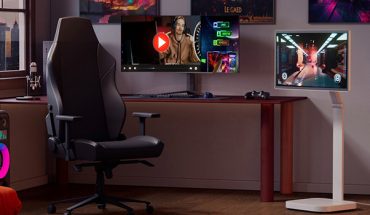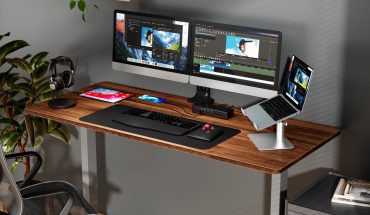The physical, emotional, and financial costs of falling down are going up.
Fall-related injuries among Canadian seniors are reaching unprecedented levels, but new health care techniques and technologies are stepping up to reduce their frequency and impact. From audible beeps to invisible radar to artificial intelligence, new fall detection and prevention technologies are designed to save lives and money.
In 2023, more than 81,600 Canadians aged 65 and older were hospitalized due to falls, marking a steep rise and record high in serious injuries among older adults. Ontario and Alberta reported some 212,500 visits to an emergency room by seniors who fell.
Worst of all, falls proved fatal for 7,189 senior citizens in 2022.
The financial toll is staggering as well: falls are estimated to cost Canada’s healthcare system $5.6 billion every year. Of course, there’s an acronym for all that: FRH, or fall-related hospitalizations. FRHs have increased nearly fifty per cent, according to hospitalization records, over the past several years.
Despite the fact that most falls are preventable accidents, they are a leading cause of injury-related hospitalizations and fatalities among older adults not just in Canada. In the U.S., falls represent the leading cause of injury for adults over 65, with more than 14 million older adults reporting falls each year, according to the Centers for Disease Control and Prevention.
Falls among older adults are a public health concern worldwide, as well. According to the World Health Organization, about a third of older adults fall each year. The percentage ranges up to 42 per cent for those 70 years or older.
But now, new gadgets, digital devices, and health care regimens are helping lower those numbers and reduce serious harm if falls do occur. Health care and med tech companies are integrating automatic fall detection systems, GPS tracking, wireless communication platforms, embedded sensors, microwave connectivity, AI and more into technology that can be easily worn by individuals or installed in their living quarters.
Simple medical alert devices are common: be they a pendant around your neck or a watch on your wrist. In an emergency, they can be activated by a button push which opens a direct communication channel to a medical attendant as needed.
Automatic fall detection systems up the ante by using sensors like accelerometers to detect speed or motion, and gyroscopes to detect rotation or what’s called angular velocity. These sensors produce data that algorithms can use to identify a fall or tell the difference between an actual fall and a false alarm. The technology has improved dramatically in recent years, with thousands of medical researchers and technology developers around the world exploring ways to use machine learning and artificial intelligence to make fall detection even more effective.
One approach is to match the medical alert or fall detection technology with a digital twin, a virtual patient portrait made from the real-time data from monitored patients, collected by medical devices, wearables and caregiver applications. Comparing the twin with the patient can help uncover medial issues or risks.
LogicMark, for example, a U.S.-based health care tech company providing personal emergency response systems (PERS), has unveiled its patented, AI-powered Care Village Digital Twin predictive health platform. It is used to create a baseline wellness profile for each person under care. It can predict potential falls and health-related events, model other health outcomes, and support personalized care.
Meanwhile, sophisticated, non-intrusive fall detection technology is being developed here in Canada by a company called Bedford Medical Alert. Its in-home patient monitoring and fall detection system is now equipped with passive, non-wearable automatic fall detection technology that uses radar!
Bedford’s AI-powered mmWave Radar Fall Detection system was developed for environments in which a patient’s cognitive impairment can make traditional care more complicated, the company reports. It can be used in specific elder care or support units, assisted living communities, and private homes with live-in care.
It uses millimetre-wave radar (a very short wavelength signal that reflects off encountered objects) to detect falls by monitoring and analyzing a person’s motion, velocity, and body position. If necessary, it sends automatic alerts to a caregiver or medical attendant.
Another emerging technology that helps analyze and detect falls is right under foot – quite literally.
Developed by researchers and technologists at the Georgia Institute of Technology, this new wearable electronic device loaded with sensors can be slipped inside your shoes.
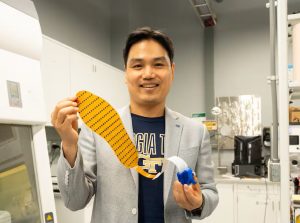
Hong Yeo holds the wearable electronic device made of more than 170 thin, flexible sensors that measure foot pressure, and may indicate balance issues or walking risks. (Georgia Tech image by Joya Chapman).
It’s like those foot pad or shoe cushions we slip in our shoes for comfort, but this one has more than 170 thin, flexible sensors that collect foot pressure data in real-time. Such information is an important medical metric used to tell if someone is or walks off-balance, which often leads to falls.
The wearable is thin enough to be comfortable for the wearer and easy to integrate with other assistive technologies. Bluetooth capabilities allow the device to connect to a smartphone app and health monitoring applications.
Of course, once machine learning algorithms and artificial intelligence are applied, the sensor-laden shoe insert can be used to predict falls, monitor rehab treatments, even analyze athletic performance.
Even better, describes Hong Yeo, Georgia Tech lead researcher on the project, advanced screen-printing techniques can be used to manufacture smart insoles – and other medical devices – quickly and easily.
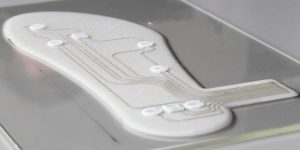
These shoe inserts or insoles, together with the integrated sensors and conductive tracks, are produced in just one step on a 3-D printer. (Photograph: Marco Binelli / ETH Zurich)
What’s more, a research team from ETH Zurich University in Switzerland is using 3-D printing to make a customized insole with integrated pressure sensors that can measure the pressure on the sole of the foot during various activities. Permanent shoe insoles with different hard and soft zones (for even greater comfort and durability) can be produced using 3-D printing, and the integration of sensors means athletes in training or patients in physiotherapy can measure their progress.
Progress can also be measured simply by watching and listening, it turns out.
Maintaining a proper balance and a good gait is critical to avoid falls. Gait refers to the step, the pace, the manner of a person’s walk. A poor gait can increase the strain on leg joints and muscles, and it increases the risk of falling.
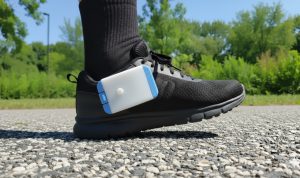
The Heel2Toe™ device, developed by PhysioBiometrics, clips to the side of a shoe and gives auditory feedback to encourage better walking. (CNW Group/AGE-WELL)
To train people to walk better, to have a safer and more secure gait, a Canadian company has just unveiled a new trademarked wearable therapeutic device.
Called Heel2Toe, the device fastens to the side of a shoe; it has three embedded inertial measurement units, so it can accurately track and assess walking patterns in real-time.
Physiotherapists and physicians co-founded the company, PhysioBiometrics Inc. in Montreal, and they developed the device with support from McGill University’s Biomedical Engineering Department.
They say a good step begins with a strong heel strike (see below for more) and so the Heel2Toe device beeps with each good step the wearer takes.
By giving the brain a reward and positive feedback in the form of an audible beep each time a step begins with a strong heel strike, a person’s gait pattern can be improved. In early phase testing, patients say the training is effective and that they can better remember which good foot movement produces the good sound.
With a therapist’s supervision, the training can be conducted anywhere, and patients receive an instructional video, an exercise book and access to an online dashboard displaying walking analytics and other information.
PhysioBiometrics received support from AGE-WELL, a Canadian network of aging support and technology companies, while developing the device, and it received funding from McGill’s Healthy Brains, Healthy Lives, McGill Innovation Fund, and MEDTECH, the Canadian association for medical technology.
The company says its Class 1 medical device is available worldwide through Shopify.
# # #
The First Step of Your Journey
Our gait or style of walking tends to worsen with age, and that can lead to a fall.
Balance, pace, step and rhythm of walking can be negatively impacted by medical, neurological or orthopedic conditions. The fact that a senior’s psychomotor skills may be slowing will certainly impact how he or she walks. And sometimes, just the fear of falling can cause a fall.
With a lower confidence level, people often change their gait, taking short little shuffling steps that can increase the risk of a fall.
So, the advice from physiatrists, physicians, and podiatrists alike is start your step with a strong heel strike. Roll from the heel to the toe on a foot flat; don’t land with a thud. If the foot scuffs, shuffles or slides, the risk of tripping and falling increases. A poor stride puts added pressure or impact on your joints.
Swing your arms easily from the shoulders, and don’t leg-reach out too far with the next step. A smooth stride is a better and faster way to walk.
Of course, a good gait is founded on a good posture – stand as tall as possible by straightening your spine as if you were being pulled by a string attached to the crown of your head.
Among the many sources of tips for preventing falls, try You CAN Prevent Falls, from Health Canada; Preventing Falls put out by The Ottawa Hospital; or Falls in Seniors, from the Canadian injury prevention organization, Parachute.
-30-

